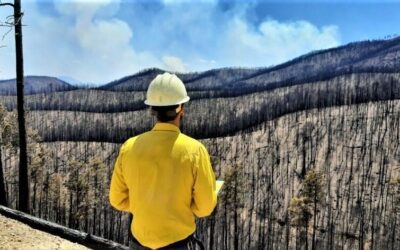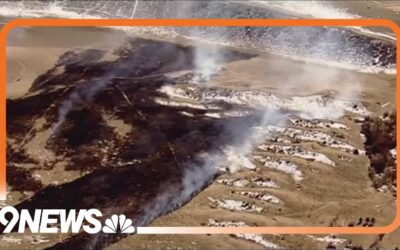Three predictors of fire behavior: weather, topography, and fuel

There are three predictors when calculating fire behavior in the wildland-urban interface (WUI): weather, topography, and fuel. (Photo by Pixabay.)
By Seth Barker | FireRescue Magazine Volume 13, Issue 1
There are three predictors when calculating fire behavior in the wildland-urban interface (WUI): weather, topography, and fuel. We can look at each one independently or together; each topic is a discussion in itself. The Campbell Prediction System discusses the forces behind each one of these topics and how they can greatly influence the intensity and speed of a wildland fire. When the three elements are working in each other’s favor, this is termed full alignment.
Fire Predictions
How does this work? There are many contributing factors. The most important topics within each one includes the following:
• Weather: strong steady winds more than 20 miles per hour.
• Topography: steep slope.
• Fuel: dry, heavy fuel load.
When the wind is traveling at a significant speed up a steep slope with a dry heavy fuel load, we have “full alignment.” As discussed in the Campbell Prediction System, we can determine where the fire is going, how fast, and how intense it is going to be. It is a very simple way everyone can predict what the fire is going to do.
Now there are many other factors to consider such as weather forecasts, what aspect the slope is on, what time of day, burn time of the fuels, if there is lightning in the area, and if the atmosphere is stable or not. Nothing is ever as simple as it seems. However, when we get back to the basics, when the fire is in full alignment, we will have a very predictable outcome. We can use this model with many different aspects in the fire service.
Preplanning
Let’s talk about preplanning. It is a hot topic in the fire service and a must for all fire departments to accomplish in their respective jurisdiction. When we commit to helping our customers with life safety inspections, we can also update or formulate our preplan of a commercial structure. While we are ensuring community safety is at the forefront of our priority list, we can accomplish a tactical plan in case an emergency was to happen at the occupancy. The inspection is aligned with the preplan, formulating a solid tactical plan for our troops to mitigate the hazard.
From an operational standpoint, we must obtain consistency with our standard operating procedures (SOPs) and our training to be effective. The two go hand in hand. We support our firefighters by creating a clear and concise framework in which to operate. The training that is drilled becomes the tasks that are performed on the fireground. The service that is delivered to the customer is the final product. If our service is not aligned with the policies and procedures, the outcome would be less than desirable. If our training supports the SOPs and in turn delivers excellent customer service, we have a predictable outcome and we are fully aligned.
Community Needs
How about addressing our community’s needs? It’s safe to say that most of us identify the target hazards in our district and come up with a solid incident action plan to deal with an emergency as it arises. Well let’s take it one step further and target our community as a whole. How can we properly address how we are going to defend our community from a major event if we have not preplanned the event that is in the back of everyone’s minds? Unfortunately, when the wildland season is on us, that is when our customers start paying attention to the WUI environment around them.
This is an excellent opportunity to engage in public education through prevention on a neighborhood scale. Train around community member homes, preplan strategies and tactics around developments, triage structures, triage streets, and triage whole neighborhoods. Identify Look Outs, determine existing Watch Out situations, and preplan existing Safety Zones. By getting out there and training, you will engage the community in what you are doing.
When your department is out walking around neighborhoods and talking with homeowners about significant hazards that can be remedied, the homeowner becomes your best champion for making your work environment safer to operate in. Rather than telling your community in a public meeting what defensible space means, show them how by practicing and training on site. A simple demonstration on reducing ladder fuels and showing what a three-foot, noncombustible space around the home means will help you and your customer become more aligned. The key is getting out there and doing it. Don’t tell people how to do it; show them how it’s done. Showing the training and capabilities that your fire department possesses, how that training relates to how the work is done, how the work is influenced by the environment it is being performed in, and how that environment can be made safe is full alignment.
Now, the customers we have been working so hard with can lead the way for others to follow. That same family can influence their neighbors to be better stewards of the WUI community. It is not as easy as chalking up a win when one homeowner creates 30 feet of defensible space around the home. One house on Anyroad, USA, that is defendable does not mean the whole subdivision is. The road, street, or cul-de-sac must be defendable. It is not reasonable to think that we will commit to one street that has most of the homes that are not defendable because of many wildland hazards when one home has a safety zone, defensible space, and excellent landscaping that is conducive to slowing down a wildland fire. We must look at our community with a much bigger lens to be ready. We must preplan our neighborhoods. The community needs to realize that one engine cannot defend 10 homes (although sometimes possible). They need to understand our honest capabilities. They need to be shown how they can set us up for success—not move obstacles in our way.
Education In Season
Unfortunately, the best time to do this is during wildland season. It’s when the public is overloaded with wildfire news that our customers are paying the most attention. They want to know how they can help. Show them. Show them you care. Show them how they can be safer to help you operate safer. The customer becomes the mitigator, the champion, the teacher for others to follow.
The firefighters’ training supports the SOPs, the SOPs support the chief’s mission, the mission supports excellent customer service to our customers, our customers support our community, and our community supports the fire department. We can predict the behavior of our firefighters, fire department, and community. We can have a predictable outcome, a safer place for our customers and the fire department—full alignment.
 Seth Barker is a captain and training officer for the Big Sky (MT) Fire Department. He is a state fire instructor for the Montana State Fire Service Training School and a state lead EMS instructor. Barker has a Blue Card Instructor certification, is an ISFSI instructor, and is one of the curators for FirefighterCloseCalls.com.
Seth Barker is a captain and training officer for the Big Sky (MT) Fire Department. He is a state fire instructor for the Montana State Fire Service Training School and a state lead EMS instructor. Barker has a Blue Card Instructor certification, is an ISFSI instructor, and is one of the curators for FirefighterCloseCalls.com.




